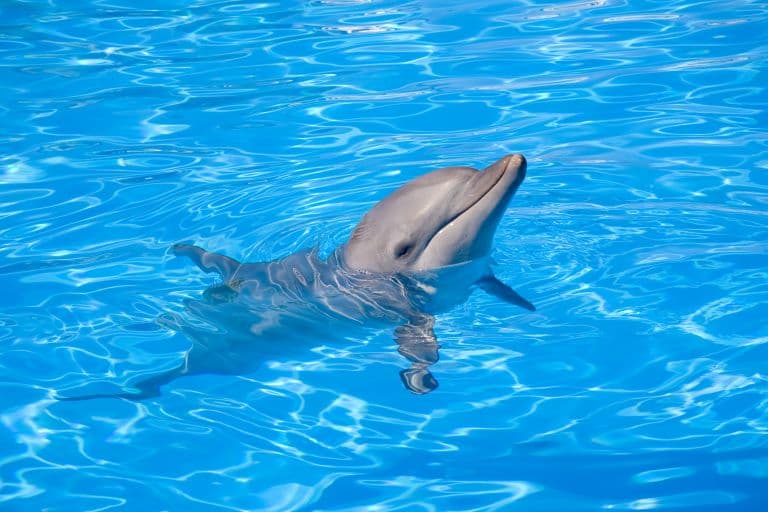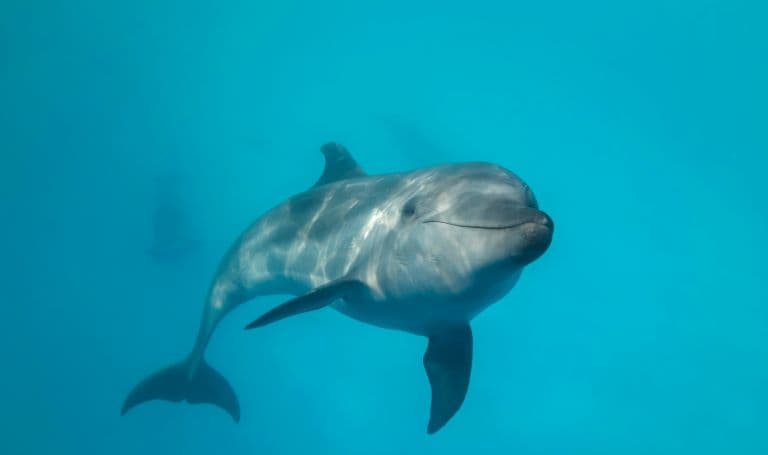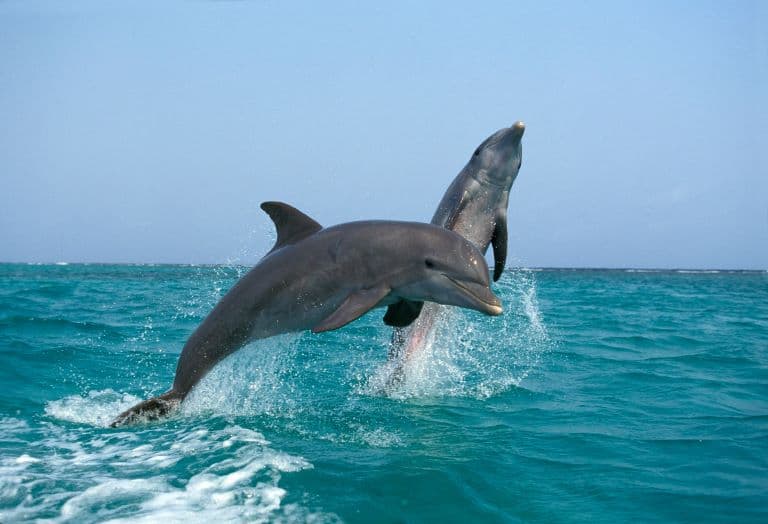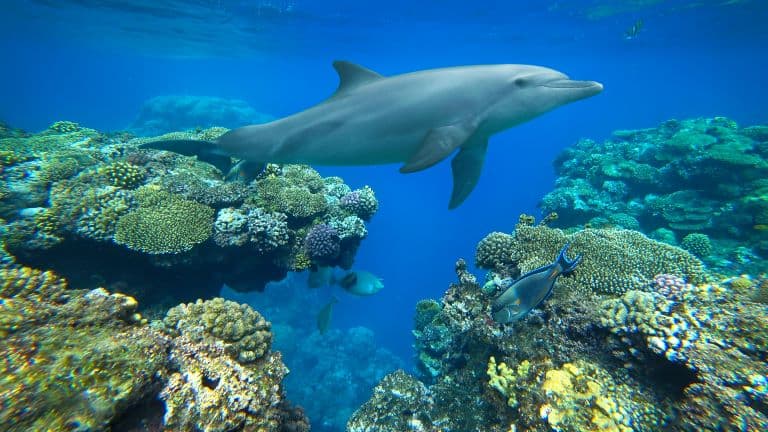Bottlenose Dolphin Profile
Toothed whales hold the key to the human race’s reconnection with nature. Here is a group of animals whose intelligence, social behaviour and random brutality so reflect our own, and whose intricate vocal language could tell us so much about them and ourselves, yet here we are making them do backflips in ponds for gawking soda drinkers and their tubby children.
There’s no better example of this than the bottlenose dolphin: an animal whose perpetual smile and apparent fondness for humans belies a history of abuse and neglect at our hands.

Bottlenose Dolphin Facts Overview
| Habitat: | Marine, warm and temperate waters |
| Location: | Worldwide except polar waters |
| Lifespan: | Up to 60 years |
| Size: | 4 meters (13 feet) |
| Weight: | Average weight around 300 kg (660 pounds), max 650 kg (1,430 lb) |
| Colour: | Grey, bluish grey, sometimes black |
| Diet: | Fish, shrimp, molluscs |
| Predators: | Large sharks |
| Top Speed: | 35 km/h (24 mph) |
| No. of Species: | 3 |
| Conservation Status: | Least Concern to Near Threatened (IUCN) |
Bottlenose dolphins are clearly one of the smartest animals on the planet, and while we associate them more with the cuddly plush toys sold in the Aquarium gift shop, they’re immense, powerful hunters of the ocean, and capable of far more than cheap tricks.
Like any highly intelligent animal, they show a mix of empathy and brutality but there’s no question that they deserve a lot better than they’ve been given and that the ocean belongs to them, as it has done for around 50 million years longer than we’ve even existed.
Interesting Bottlenose Dolphin Facts
1. They’re big
Dolphins are a diverse lot, ranging from the tiny Vaquita to the colossal orca. The latter makes the common bottlenose dolphin appear relatively small, but this is a forced perspective.
There’s nothing small about these dolphins; adult males can reach upwards of four meters long, not far off the dimensions of a large Great white shark.
And they’re no less predatory, either. Bottlenose dolphins are top killers in much of their range, and unlike the iconic shark, they hunt in packs. 1

2. They’re smart
This high level of sociality comes with an enormous cognitive requirement, which in bottlenose dolphins, is supported by one of the largest brains in the animal kingdom.
All toothed whales have complex brains, the sperm whale being the owner of the largest such organ in the world. Bottlenose dolphins have brains roughly the same size as that of humans – in fact, a little bigger – and their brain-to-bodyweight ratio is just a little less, second only to the skinny, naked ape (and possibly the Right whale dolphin).
Spatial awareness is super important underwater, and dolphins have a large amount of brain power dedicated to this and echolocation. They’ve been seen using tools, have culture, and can count.
They’re smart enough to cooperate with human fishermen to herd fish into nets so that they can pick off some of the stragglers.
Dolphins are perhaps more intelligent than humans in this regard, as deliberate human cooperation with dolphins is hard to find, even though they can talk. 2
3. They can talk
This bears repeating: they can talk!
The fact that this isn’t the primary focus of all natural sciences remains a constant reminder of our arrogance and ignorance as a species.
Like all toothed whales, dolphins have a complex set of sounds they make, in various contexts. One of the most common involved strings of pulses, squeaks and whistles that make up their language.
We have been bafflingly uninterested in this as a species, and so funding for its research remains limited, but it’s clear that these animals have a language that has a lot of similarities to our own.
Dolphins have names for themselves, as well as family names, and regularly hold long conversations with one another, the details of which are apparently so unimportant that only a few clusters of renegade, self-funded researchers are trying to find out.
They also have accents and dialogues, and individual dolphins can be associated with different regions by how they talk. 3

4. They’re ferocious
While these are clearly intelligent, social mammals, they’re also kinda rapey. On multiple occasions, a well-wishing dolphin-experiencing tourist has found themselves faced with the business end of a bull dolphin’s reproductive organ (this has also, on occasion, been welcomed).
Female dolphins don’t have it any easier, and sex in this community is usually a one-sided event, often involving roving gangs of males.
But it’s not only sex, they’re killers by nature, and can be a bit cruel in the wild. Dolphins have been known to kill porpoises for no other apparent reason than racism, and they’ll sometimes kill their own kind if they don’t like the look of them, too. 4 5
5. They can be kind
Like humans, the dolphins’ brutal side can be offset somewhat by random acts of kindness. Historically, dolphins are well known as helpful, non-rapey protectors of humans, pulling up injured divers to the surface to breathe, or gathering around groups of swimmers to protect them from a marauding shark.
Nobody is quite sure why animals like this don’t eat us. While bottlenose dolphins are more into fish, orcas certainly have the chops for it, yet they, too, choose to ignore us as a prey item.
Some people like to think it’s because they recognise us as intelligent and good, neither of which is likely as true as we want it to be, considering how many of them we kill each year (300,000+ die as bycatch); a more likely reason is that all the crap we eat makes us taste disgusting or that our spindly limbs and total ineptitude in water make us worthy of pity.
6. They’re fast
Being big and ferocious is one thing, but these babies are almost all muscle. Under a protective but thin layer of blubber sits a compact, powerful body, rigid and dense, and perfect for pushing its streamlined bulk through the water.
Some research suggests that there’s a soft limit to how fast an animal can move through the water due to the exponential increase of the effects of drag as speed increases, and this likely can only be avoided using special mechanisms like cavitation, as seen in extraordinarily fast torpedoes.
But this cavitation would cause tremendous damage to the delicate membranes of marine animals.
The estimated upper limit is around 35 km/h and therefore throws into question wild tales of extreme speeds like 109 km/h in the sailfish, among many others. But bottlenose dolphins are well studied by scientists, and their top speed is right on this theoretical limit, so it’s safe to say that they’re one of the fastest animals in the ocean, having been clocked at around 35 km/h in short bursts.
This goes to show that we’re very much still in the era of nautical legends and should be sceptical of what sailors and fishermen state as fact!

7. They can commit suicide
Being such a fast, powerful and smart animal, captivity can lead quickly to mental illness, and dolphins are the only non-human animals that are more or less confirmed to have committed suicide.
The dolphin who played Flipper is a famous example, but there are multiple accounts of very sad dolphins drowning themselves in their tanks.
Captive dolphins have been known to become depressed when separated from the trainers they love, and since dolphins are voluntary breathers – they have to choose to take a breath – it’s trivial to sink down and decide not to
8. They do not belong in captivity
This is why there is no ethical means of keeping dolphins captive. These are perhaps the most intelligent animals on the planet, and they have far greater basic needs than can ever be provided for in aquariums.
Dolphin shows are highly popular on account of the trainability of these performers, but each dolphin in them has either been captured and imprisoned or bred from one who was, usually with devastating consequences to the animal’s mental health.
Bottlenose Dolphin Fact-File Summary
Scientific Classification
| Kingdom: | Animalia |
| Phylum: | Chordata |
| Class: | Mammalia |
| Order: | Artiodactyla |
| Family: | Delphinidae |
| Genus: | Tursiops |
Fact Sources & References
- “Common Bottlenose Dolphin”, Oceana.
- (2004), “Humans and Dolphins: If Brain Size is a Measure, We’re Not That Different”, U.S National Science Foundation.
- “Understand What Whales are Saying”, Project CETI.
- (2014), “Can Dolphins Rape Humans?”, Washington City Paper.
- Author Name (Year), “Dolphin’s Dark Side Uncovered: The Shocking Truth”, Wildlife x Team.
